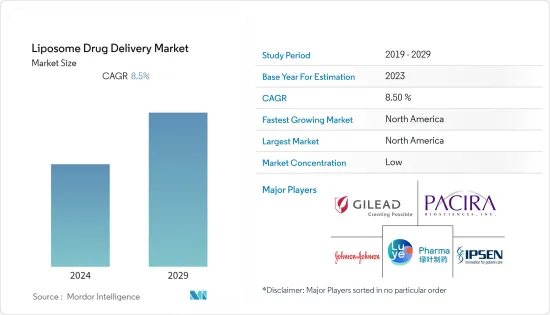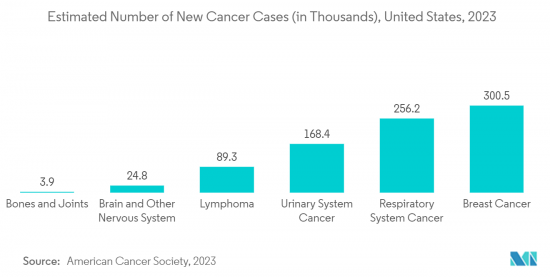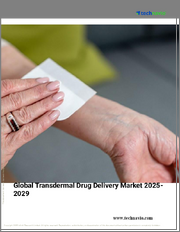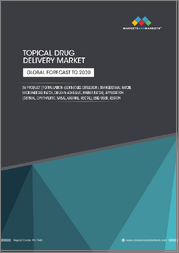
|
시장보고서
상품코드
1407049
리포솜 약물전달 시장 : 점유율 분석, 산업 동향 및 통계, 성장 예측(2024-2029년)Liposome Drug Delivery - Market Share Analysis, Industry Trends & Statistics, Growth Forecasts 2024 - 2029 |
||||||
리포솜 약물전달(Liposome Drug Delivery) 시장은 본 연구의 예측 기간 동안 CAGR 8.5%로 추이하며 성장 할 것으로 예측됩니다.

COVID-19는 리포솜 약물전달와 관련된 다양한 연구개발 활동이 각국 정부에 의해 세계에서 연기되었기 때문에 리포솜 약물전달 시장에 영향을 주었습니다. 그러나 약물전달에서 리포솜의 중요성은 빨리 인정되었고, COVID-19의 치료를 위한 리포솜 약물전달 시스템에 대한 집중적인 조사가 시작되어, 팬데믹성 후기 시장 성장을 가속하였습니다. 예를 들어, 2021년 11월에 Pharmaceutical Sciences of Asian Journal에 게재된 연구에 따르면, 연구원은 동결건조 렘데시비르 리포솜(Rdv-lips)을 개발한 리포솜의 캡슐화에 의해 렘데시비르의 용해도가 크게 향상되고 생체 친화성이 향상되어 약물전달의 효과가 높아졌습니다. 리포솜을 기반으로 하는 약물과 백신이 중요한 역할을 하는 COVID-19에 대한 치료제 개발에 기업이 현재도 노력하고 있기 때문에 시장은 현재 시나리오에서 성장하고 있습니다.
리포솜 약물전달 시장 성장을 가속하는 주요 요인은 리포솜 약물전달 방법이 다른 전달 시스템보다 일정한 이점을 제공하기 때문에 효과적이고 효율적인 치료제에 대한 수요가 증가하고 있다는 것입니다. 입니다. 예를 들어, 2022년 2월에 Molecules Journal 잡지에 게재된 조사에 따르면, 리포솜은 표준 약물전달 방법보다 우수한 특성을 가지며, 예를 들어 부위 표적화, 방출의 연장 또는 제어, 분해 와 클리어런스로부터 약물의 보호, 높은 치료 효과, 독성의 부작용의 경감 등을 들 수 있습니다.
또한 약물 전달을 돕기 위해 리포좀을 적용하면 치료 화합물을 안정화하고, 세포 및 조직 흡수 장애물을 극복하며, 생체 내 표적 부위에 대한 화합물의 생체 분포를 개선하는 데 도움이 되는 것으로 나타났습니다. 이를 통해 전신 독성을 최소화하면서 캡슐화된 화합물을 표적 부위에 효과적으로 전달할 수 있습니다. 리포솜은 다양한 전달 문제를 해결하기 위해 쉽게 조작할 수 있는 적응 가능한 물리화학적 및 생물물리학적 특성으로 인해 매력적인 전달 시스템입니다. 따라서 의약품 제조업체들이 리포솜을 선호합니다.
또한 암, 당뇨병, 진균 감염 등 만성질환의 세계 만연에 따라 효과적인 치료제에 대한 수요가 증가하고 있으며, 리포솜 약물전달 시장 성장을 가속할 것으로 기대되고 있습니다. 예를 들어, 국제 당뇨병 연합(IDF)의 2021년 12월 갱신에 따르면, 2021년에는 세계 20-79세의 성인이 약 5억 3,700만명 당뇨병을 앓고 있으며, 이 수는 2030년에는 6억 4,300만 명, 2045년에는 7억 8,300만 명에 이를 것으로 추정됩니다. 세계 당뇨병 환자 수 증가가 예측됨에 따라 효능을 높이고 독성을 줄이는 리포솜 당뇨병 치료제 수요가 높아지고 연구 대상 시장 성장이 촉진될 것으로 기대됩니다.
또한 리포솜 약물전달법의 진보가 진행되고 있으며, 이 분야에 대한 새로운 투자와 시장 진출기업에 의한 제품의 출시, 인수, 제휴가 리포솜 약물전달 시장 성장을 더욱 밀어올릴 것으로 예상됩니다. 예를 들어 2021년 10월 부형제, 제제기술, 임상·상업제조를 제공하는 종합개발제조위탁기관(CDMO)인 에보닉 헬스케어는 정평 LIPEX 리포솜 압출기의 새로운 버전을 출시했습니다. LIPEX Flow는 보다 효율적인 차세대 고압 압출기 시장 요구를 충족시키고 암 치료제, 백신 및 기타 용도를 비롯한 전통적인 리포솜 약물전달이 필요한 의약품을 제조합니다.
따라서 위의 요인으로 조사 대상 시장은 조사 기간 동안 큰 성장을 이룰 것으로 예상됩니다. 그러나 약물전달과 관련된 엄격한 규제 정책과 부작용은 조사 예측 기간 동안 리포솜 약물전달 시장 성장을 억제할 것으로 예상됩니다.
리포솜 약물전달 시장 동향
예측 기간 동안 암 치료제가 최대 시장 점유율을 차지할 전망
암 치료제는 세계적으로 암의 유병률이 높고, 선진적인 치료제에 대한 수요가 높아지고 있기 때문에 큰 점유율을 차지할 것으로 예상되고 있습니다. 예를 들어 호주보건복지연구소(AIHW)의 2022년 보고서에 따르면 호주는 2022년에 총 162,000명의 신규암 환자가 진단되었습니다. 또한 Canadian Medical Association Journal의 2022년 5월 보고서에 따르면 캐나다에서는 2022년에 28,600명의 유방암 환자가 새롭게 진단되었습니다. 세계적으로 암 부담이 크므로 예측 기간 동안 이 부문의 성장을 가속할 것으로 예상됩니다.
또한, 2021년 5월에 Nanoscale Research Letters에 게재된 조사 연구에 따르면, 리포솜의 높은 유연성과 다양한 폴리머, 리간드, 분자를 결합시킴으로써 화학 수식 능력이 암 치료에서 리포솜에 큰 플러스 이며, 약리학적 이점을 증대시켜 항암 치료 효과를 높입니다. 또한, 동일한 출처에 따르면, 리포솜은 항암성 종양제의 감도, 특이성 및 체내 지속성을 향출시킬 수 있기 때문에 리포솜은 암 치료제로서 널리 사용됩니다. 따라서 리포솜은 암 치료에 널리 사용됩니다. 따라서 암 치료에서 리포솜이 제공하는 연구 및 이점 증가에 따라 그 수요는 예측 기간 중에 성장할 것으로 예상되고 있습니다.
따라서, 암의 높은 유병률, 다른 것보다 리포솜 약물전달 방법의 장점으로, 암 치료 부문은 조사의 예측 기간 동안 리포솜 약물전달 시장에서 주요 점유율을 유지할 것으로 예상됩니다.

예측 기간 중 북미가 시장에서 큰 점유율을 차지할 전망
북미는 이 지역에서 만성질환의 높은 유병률, 노인 인구 증가, 시장 진출기업의 혁신적인 제품 출시 등으로 리포솜 약물전달 시장을 독점할 것으로 예측됩니다.
이 지역에서는 만성 질환의 부담이 크기 때문에 치료제에 대한 수요가 촉진되어 북미의 성장이 예상됩니다. 예를 들어, CDC의 2022년 최신 정보에 따르면 미국의 18세 이상의 성인의 관상동맥 심장 질환 비율은 전년의 4.6%에서 2021년에는 4.9%로 증가하고 있습니다. 또한 2023년 미국 암협회 통계에 따르면 미국에서는 2023년 약 190만명의 암 환자가 새롭게 진단될 것으로 예측되고 있습니다. 리포솜은 항원 제시 세포 및 T세포에 대한 항원 및 기타 자극 분자의 전달을 개선합니다. 따라서 리포솜에 의한 약물전달 수요는 CVD 및 암 치료제를 위해 증가하고 있습니다.
또한, 미국의 다양한 질병 연구에 대한 정부 자금이 증가하는 것도 이 지역 시장 성장에 중요한 역할을 하고 있습니다. 예를 들어, 2022 회계연도에 미국 국립암연구소에 할당된 예산은 69억 달러로 2021 회계연도에 비해 3억 5,300만 달러가 순증했습니다. 따라서 미국의 R&D에 대한 높은 지출은 예측 기간 동안 이 지역의 시장을 크게 촉진할 것으로 예상됩니다.
리포솜 약물전달 산업 개요
리포솜 약물전달 시장은 의약품 개발에 종사하는 기업이 복수 존재하고 경쟁이 치열합니다. 또한 이 분야의 기업은 신출시, 제휴, 파트너십, 합병, 인수를 통해 제품 제공을 지속적으로 강화하고 있으며, 시장 경쟁을 더욱 치열하게 만들 것으로 예상됩니다. 리포솜 약물전달 시장의 주요 기업으로는 Gilead Sciences, Inc., Pacira BioSciences, Inc., Luye Pharma Group, Johnson and Johnson, Ipsen Biopharmaceuticals, Inc. 등이 있습니다.
기타 혜택 :
- 엑셀 형식 시장 예측(ME) 시트
- 3개월간 애널리스트 서포트
목차
제1장 서론
- 조사 전제 조건 및 시장 정의
- 조사 범위
제2장 조사 방법
제3장 주요 요약
제4장 시장 역학
- 시장 개요
- 시장 성장 촉진 요인
- 암과 같은 만성질환 유병률 상승
- 리포솜 약물전달 시스템의 장점
- 시장 성장 억제 요인
- 약물전달과 관련된 엄격한 규제 정책과 부작용
- Porter's Five Forces 분석
- 신규 참가업체의 위협
- 구매자/소비자의 협상력
- 공급기업의 협상력
- 대체품의 위협
- 경쟁 기업간 경쟁 관계의 강도
제5장 시장 세분화(시장 규모)
- 제품별
- 파클리탁셀 리포솜
- 리포소말독소루비신
- 리포소말 암포테리신 B
- 기타
- 기술별
- 스텔스 리포솜 기술
- 비PEG화 리포솜 기술
- 디포폼 리포솜 기술
- 적응증별
- 곰팡이 감염/질환
- 암 치료제
- 통증 관리
- 바이러스 백신
- 기타
- 지역
- 북미
- 미국
- 캐나다
- 멕시코
- 유럽
- 독일
- 영국
- 프랑스
- 이탈리아
- 스페인
- 기타 유럽
- 아시아 태평양
- 중국
- 일본
- 인도
- 호주
- 한국
- 기타 아시아 태평양
- 중동 및 아프리카
- GCC
- 남아프리카공화국
- 기타 중동 및 아프리카
- 남미
- 브라질
- 아르헨티나
- 기타 남미
- 북미
제6장 경쟁 구도
- 기업 개요
- Gilead Sciences, Inc.
- Pacira BioSciences, Inc.
- Spectrum Pharmaceuticals, Inc.
- Takeda Pharmaceutical Company Limited
- Luye Pharma Group
- Johnson and Johnson
- Ipsen Pharma
- Celsion Corporation
- Teva Pharmaceutical Industries Ltd.
- Novartis AG
- Sun Pharmaceutical
- Acrotech Biopharma, Inc.
제7장 시장 기회 및 향후 동향
LYJ 24.01.29
The liposome drug delivery market is expected to register a CAGR of 8.5% during the forecast period of the study.
COVID-19 impacted the liposome drug delivery market as various R&D activities involving liposome drug delivery were postponed around the world by the respective government of the countries. However, the importance of liposomes in drug delivery was realized soon and intensive research started on the liposome drug delivery system for the treatment of COVID-19 which propelled the market growth in the later phase of the pandemic. For instance, according to the research study published in the Asian Journal of Pharmaceutical Sciences in November 2021, the researchers developed lyophilized remdesivir liposomes (Rdv-lips), which could be reconstituted as a liposomal aerosol for pulmonary delivery to improve the in vivo behavior of existing remdesivir cyclodextrin conclusion compound (Rdv-cyc) injections and liposome encapsulation endowed remdesivir with much higher solubility and better biocompatibility, and thus, increased the efficacy of the drug. The market is growing in the current scenario because the companies are still engaged in the development of therapeutics against COVID-19, in which liposome-based drugs or vaccines can play a vital role.
The major factor driving the growth of the liposome drug delivery market is the increasing demand for effective and efficient therapeutics since liposome-based drug delivery method offers certain advantages over other delivery systems. For instance, according to the research study published in Molecules Journal in February 2022, liposomes have better properties than standard drug delivery methods, such as site-targeting, prolonged or controlled release, drug protection from degradation and clearance, higher therapeutic effects, and lesser toxic side effects.
Also, the application of liposomes to assist drug delivery has shown to be beneficial for stabilizing therapeutic compounds, overcoming obstacles to cellular and tissue uptake, and improving the biodistribution of compounds to target sites in vivo. This enables the effective delivery of encapsulated compounds to target sites while minimizing systemic toxicity. Liposomes are an appealing delivery system due to their adaptable physicochemical and biophysical properties, which allow for easy manipulation to address various delivery concerns. Hence, they are the preferred choice of drug manufacturers.
Furthermore, with the increasing prevalence of chronic diseases such as cancer, diabetes, fungal infections, and others around the world, the demand for effective therapeutics is increasing, which is expected to fuel the growth of the liposome drug delivery market. For instance, according to the December 2021 update of the International Diabetes Federation (IDF), about 537 million adults of age 20 to 79 years were living with diabetes around the world in 2021, and this number is estimated to reach 643 million by 2030 and 783 million by 2045. The projected rise in the number of diabetes cases globally is expected to boost demand for liposomal diabetes therapeutics to increase its efficacy and reduce the toxicity and hence, drive growth of the studied market.
In addition, the increasing advancement in the liposomal drug delivery method with the new investments in the area along with product launches, acquisitions, and collaborations by the market players is further expected to boost the growth of the liposome drug delivery market. For instance, in October 2021, Evonik Health Care, an integrated contract development and manufacturing organization (CDMO) that offers excipients, formulation technologies, and clinical and commercial manufacturing, launched a new version of its established LIPEX liposome extruder. LIPEX Flow meets the market need for more efficient, next-generation high-pressure extruders to produce drug products requiring conventional liposomal drug delivery, including drugs for oncology, vaccines, and other applications.
Therefore, owing to the above-mentioned factors, the studied market is expected to experience significant growth during the study period. However, stringent regulatory policies and adverse effects associated with drug delivery are expected to restrain the growth of the liposome drug delivery market during the forecast period of the study.
Liposome Drug Delivery Market Trends
Cancer Therapeutics are Expected to Account for the Largest Market Share During the Forecast Period
Cancer therapeutics are expected to hold a significant share due to the high prevalence of cancer globally and the rising demand for advanced therapeutics. For instance, as per the Australian Institute of Health and Welfare (AIHW) 2022 report, a total of 162,000 new cancer cases were diagnosed in Australia in 2022. Also, as per Canadian Medical Association Journal, May 2022 report, 28,600 new breast cancer were diagnosed in Canada in 2022. The high burden of cancer globally is expected to propel the segment's growth during the forecast period.
Furthermore, according to the research study published in Nanoscale Research Letters in May 2021, liposomes' high flexibility and capacity for chemical modification by conjugating diverse polymers, ligands, and molecules are a big positive for liposomes in cancer therapeutics, and it increases their pharmacological merits and boosts anticancer treatment effectiveness. Further, as per the same source, liposomes can improve the sensitivity, specificity, and persistence of anti-malignant cell agents in the body, and thus, liposomes are used widely in cancer therapeutics. Therefore, with the rising research studies and advantages offered by liposomes in cancer therapeutics, its demand is expected to witness growth during the forecast period.
Therefore, due to the high prevalence of cancer, the advantages of liposome drug delivery methods over others, the cancer therapeutics segment is expected to hold a major share in the liposome drug delivery market during the forecast period of the study.

North America is Expected to Hold a Significant Share in the Market over the Forecast Period
North America is expected to dominate the liposome drug delivery market due to the high prevalence of chronic diseases in the region, the increasing geriatric population, and the launches of innovative products by the market players.
The high burden of chronic diseases in the region is expected to propel the demand for therapeutics, which is expected to drive growth in the North American region. For instance, according to the CDC's 2022 update, the percentage of coronary heart disease for adults aged 18 and over in the United States increased to 4.9% in 2021 as compared to 4.6% in the previous years. Additionally, according to the American Cancer Society statistics of 2023, around 1.9 million new cancer cases are predicted to be diagnosed in the United States in 2023. Liposomes improve the delivery of antigens and other stimulatory molecules to antigen-presenting cells or T cells. Therefore, the demand for liposome drug delivery is rising for CVD and cancer therapeutics.
Furthermore, the rising government funding for research of various diseases in the United States also plays a crucial role in the growth of the market in the region. For instance, the allocated budget for the National Cancer Institute (United States) for FY 2022 was USD 6.9 billion, which was USD 353 million net increase over FY 2021. Thus, the high spending for R&D in the United States is expected to significantly propel the market in the region during the forecast period.
Liposome Drug Delivery Industry Overview
The liposome drug delivery market is highly competitive with the presence of several players in the market who are engaged in the development of drugs. Also, the companies in the area are continuously enhancing their product offering through new launches, collaborations, partnerships, mergers, and acquisitions which are further expected to increase the competition in the studied market. Some of the key players in the liposome drug delivery market are Gilead Sciences, Inc., Pacira BioSciences, Inc., Luye Pharma Group, Johnson and Johnson, and Ipsen Biopharmaceuticals, Inc., among others.
Additional Benefits:
- The market estimate (ME) sheet in Excel format
- 3 months of analyst support
TABLE OF CONTENTS
1 INTRODUCTION
- 1.1 Study Assumptions and Market Definition
- 1.2 Scope of the Study
2 RESEARCH METHODOLOGY
3 EXECUTIVE SUMMARY
4 MARKET DYNAMICS
- 4.1 Market Overview
- 4.2 Market Drivers
- 4.2.1 Rising Prevalence of Cronic Diseases Like Cancer
- 4.2.2 Advantages Associated With The Liposome Drug Delivery System
- 4.3 Market Restraints
- 4.3.1 Stringent Regulatory Policies and Adverse Effects Associated with the Drug Delivery
- 4.4 Porter's Five Forces Analysis
- 4.4.1 Threat of New Entrants
- 4.4.2 Bargaining Power of Buyers/Consumers
- 4.4.3 Bargaining Power of Suppliers
- 4.4.4 Threat of Substitute Products
- 4.4.5 Intensity of Competitive Rivalry
5 MARKET SEGMENTATION (Market Size by Value - in USD Million)
- 5.1 By Product
- 5.1.1 Liposomal Paclitaxel
- 5.1.2 Liposomal Doxorubicin
- 5.1.3 Liposomal Amphotericin B
- 5.1.4 Others
- 5.2 By Technique
- 5.2.1 Stealth Liposome Technology
- 5.2.2 Non-PEGylated Liposome Technology
- 5.2.3 DepoFoam Liposome Technology
- 5.3 By Indication
- 5.3.1 Fungal Infections/Diseases
- 5.3.2 Cancer Therapeutics
- 5.3.3 Pain Management
- 5.3.4 Viral Vaccines
- 5.3.5 Others
- 5.4 Geography
- 5.4.1 North America
- 5.4.1.1 United States
- 5.4.1.2 Canada
- 5.4.1.3 Mexico
- 5.4.2 Europe
- 5.4.2.1 Germany
- 5.4.2.2 United Kingdom
- 5.4.2.3 France
- 5.4.2.4 Italy
- 5.4.2.5 Spain
- 5.4.2.6 Rest of Europe
- 5.4.3 Asia-Pacific
- 5.4.3.1 China
- 5.4.3.2 Japan
- 5.4.3.3 India
- 5.4.3.4 Australia
- 5.4.3.5 South Korea
- 5.4.3.6 Rest of Asia-Pacific
- 5.4.4 Middle East and Africa
- 5.4.4.1 GCC
- 5.4.4.2 South Africa
- 5.4.4.3 Rest of Middle East and Africa
- 5.4.5 South America
- 5.4.5.1 Brazil
- 5.4.5.2 Argentina
- 5.4.5.3 Rest of South America
- 5.4.1 North America
6 COMPETITIVE LANDSCAPE
- 6.1 Company Profiles
- 6.1.1 Gilead Sciences, Inc.
- 6.1.2 Pacira BioSciences, Inc.
- 6.1.3 Spectrum Pharmaceuticals, Inc.
- 6.1.4 Takeda Pharmaceutical Company Limited
- 6.1.5 Luye Pharma Group
- 6.1.6 Johnson and Johnson
- 6.1.7 Ipsen Pharma
- 6.1.8 Celsion Corporation
- 6.1.9 Teva Pharmaceutical Industries Ltd.
- 6.1.10 Novartis AG
- 6.1.11 Sun Pharmaceutical
- 6.1.12 Acrotech Biopharma, Inc.

















